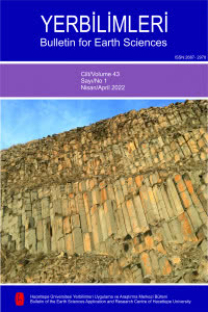Dört farklı elektrot dizilimine göre bazı üç-boyutlu sığ yeraltı yapılarının görünür özdirenç modellemesi
Apparent resistivity modelling of some three-dimensional shallow structures using by four different electrode configurations
___
Apparao, A., 1979. Model tank experiments on resolution of resistivity anomalies obtained over buried conducting dikes-inline and broadside profiling. Geophysical Prospecting, 27, 835 - 847.Berge, M.A., 2002. Sığ aramacılıkta sonlu farklar yöntemi ile iki-boyutlu düz çözüm özdirenç modellemesi. Lisans tezi, Dokuz Eylül Üniversitesi, Jeofizik Mühendisliği Bölümü, 77 s (yayımlanmamış).
Brizzolari, E., and Bernabini, M., 1979. Comparison between Schlumberger electrode arrangement and some focused electrode arrangements in resistivity profiles. Geophysical Prospecting, 27, 233 - 244.
Candansayar, M.E., and Başokur, A.T., 2001. Detecting small-scale targets by the 2D inversion of two-sided three-electrode data: application to an archaeological survey. Geophysical Prospecting, 49, 13 -25.
Coggon, J.H., 1971. Electromagnetic and electrical modeling by the finite element method. Geophysics, 36, 132-155.
Dahlin, T., 2001. The development of dc resistivity imaging techniques. Computer and Geosciences, 27, 1019-1029.
Dahlin, T., and Zhou, B., 2004. A numerical comparison of 2-D resistivity imaging with 10 electrode arrays. Geophysical Prospecting, 52, 379 -398.
Dahlin, T., Bemstone, C., and Löke, M. H., 2002. Case History: A 3-D resistivity investigation of a contaminated site at Lernacken, Sweden. Geophysics, 67, 1692-1700.
Das, U.C., and Parasnis, D.S., 1987. Resistivity and induced polarization responses of arbitrarily shaped three-dimensional bodies in a two-layered earth. Geophysical Prospecting, 35, 98-109.
Dey, A., and Morrison, H.F., 1979a. Resistivity modeling for arbitrarily shaped two-dimensional structures. Geophysical Prospecting, 27, 106-136.
Dey, A., and Morrison, H.F., 1979b. Resistivity modeling for arbitrarily shaped three-dimensional structures. Geophysics, 44, 753 -780.
Dieter, K., Paterson, N.R., and Grant, F.S., 1969. IP and resistivity type curves for three-dimensional bodies. Geophysics, 34, 615 - 632.
Edwards, L.S., 1977. A modified pseudosection for resistivity and IP. Geophysics, 42, 1020-1036.
Göktürkler, G. ve Drahor, M. G., 2004. Yinelemeli yöntemle üç boyutlu özdirenç modellemesi. Dokuz Eylül Üniversitesi, Fen ve Mühendislik Dergisi (baskıda).
Griffiths, D.H., and Barker, R.D., 1993. Two-dimensional resistivity imaging and modelling in areas of complex geology. Journal of Applied Geophysics, 29, 211-226.
Griffiths, D.H., Turnbul, J., and Olayinka, A.I., 1990. Two-dimensional resistivity mapping with a computer-controlled array. First Break, 8(4), 121-129.
Hohmann, G.W., 1975. Three-dimensional induced polarization and electromagnetic Modelling. Geophysics, 40, 309 - 324.
Jepsen, A.F., 1969. Numerical modeling in resistivity prospecting. Ph. D. Thesis, University of California, Berkeley, USA (unpublished).
Kurtulmuş, T.Ö., 2003. Sığ aramacılıkta sonlu farklar yöntemi ile üç-boyutlu özdirenç modellemesi. Lisans Tezi, Dokuz Eylül Üniversitesi, Jeofizik Mühendisliği Bölümü, 69s (yayımlanmamış).
Loke, M.H., 2001a. Res3dmod ver. 2.1, Three-dimensional resistivity and IP forward modeling using the finite difference and finite element methods.User's manual, www.geoelectrical.com.
Loke, M.H., 2001b. Tutorial: 2-D and 3-D electrical imaging surveys. Penang, Malaysia, Universiti Sains Malaysia, unpublished course notes, 121 pp, www.geoelectrical.com.
McGillivray, P.R., and Oldenburg, D.W., 1990. Methods for calculating Frechet derivatives and sensitivities for the non-linear inverse problem, a comparative study. Geophysical Prospecting, 38, 499-524.
Meyer, W.H., 1977. Computer modelling of electromagnetic prospecting methods. Ph.D. Thesis, University of California, Berkeley, USA (unpublished).
Mufti, I.R., 1976. Finite difference resistivity modelling for arbitrarily shaped two-dimensional structures. Geophysics, 41, 62 -78.
Okabe, M., 1981. Boundary element method for the arbitrarily inhomogeneities problem inelectrical prospecting. Geophysical Prospecting, 29, 39 - 59.
Parasnis, D.S., 1965. Theory and practice of electric potential and resistivity prospecting using linear current electrodes. Geoexploration, 3(1), 3-69.
Pridmore, D.F., Hohmann, G.W., Ward, S.H., and Sill, W.R., 1981. An investigation of finite element modeling for electrical and electromagnetic data in three dimensions. Geophysics, 46, 1009 -1024.
Rijo, L., 1977. Modeling of electric and electromagnetic data. Ph.D. Thesis, University of Utah, USA (unpublished).
Scriba, H., 1981. Computation of the electric potential in three-dimensional structures. Geophysical Prospecting, 29, 790 - 802.
Telford, W.M., Geldart, L.P., Sheriff, R.E., and Keys, D.A., 1976. Applied Geophysics, Cambridge University Press, Cambridge, 860 pp.
Van Nostrand, R.G., and Cook, K.L., 1966. Interpretation of resistivity data. USGS Prof. Paper, Printing Office, Washington, USA, 449 pp.
Van Overmeeren, R.A., and Ritsema, I.L., 1988. Continuous vertical electrical sounding. First Break, 6(10), 313-324.
- ISSN: 1301-2894
- Yayın Aralığı: 3
- Başlangıç: 1976
- Yayıncı: Hacettepe Üniversitesi Yerbilimleri Uygulama ve Araştırma Merkezi
Feldispat cevherinden mikanın spiral zenginleştirici ile uzaklaştırılması
MURAT KADEMLİ, Özcan Y. GÜLSOY
Manyetik ayırma ve flotasyonla magmatik ve metamorfik kayaçlardan feldispat üretimi
Özcan Y. GÜLSOY, E. Caner ORHAN, N. Metin CAN, İrfan BAYRAKTAR
Ebru Coşkun DELİBAŞ, YURDAL GENÇ
Validity of the "rubbing" method for the field determination of the shear sense of a fault surface
Güre (Giresun, KD Türkiye) granitoyidinin petrografik, jeokimyasal ve petrolojik özellikleri
Mehmet ARSLAN, Hasan KOLAYLI, İrfan TEMİZEL
Çamardı (Niğde) yöresi Tersiyer (Lütesiyen) sedimanlarının bentik foraminifer biyostratigrafisi
Mahmut G. DRAHOR, Gökhan GÖKTÜRKLER, Meriç A. BERGE, T. Özgür KURTULMUŞ
